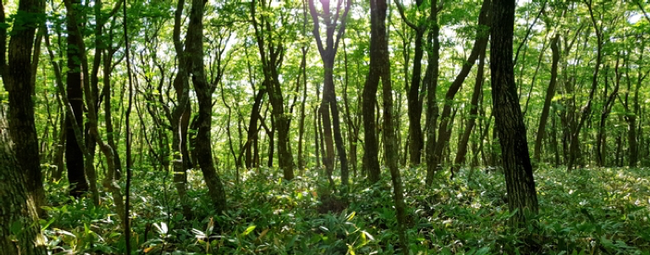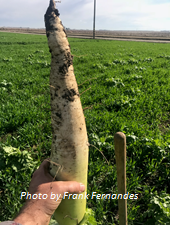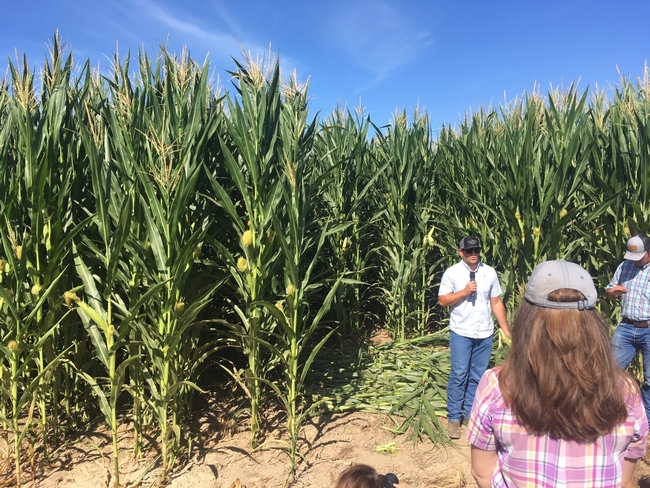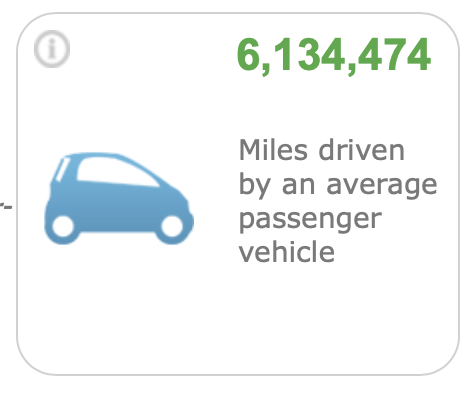- Author: Alli Rowe
- Author: Niki Mazaroli
There has been much buzz and renewed interest recently in planting trees as a tool to combat both the causes and impacts of climate change. But what role do trees play in climate-smart agriculture?
With respect to building healthy soils, tree canopy and leaf litter can provide protection against wind erosion and temperature extremes. Tree roots can help stabilize soils, increase nutrient cycling, and improve soil biota representative of a healthy soil system. The incorporation of trees and shrubs on agricultural landscapes, known as agroforestry, blends the practices of forestry and agriculture and can provide many ecological and economic benefits.
The USDA defines agroforestry as “the intentional combination of agriculture and forestry to create productive and sustainable land use practices” [1]. In theory, it really is this simple: adding trees or shrubs to an agricultural landscape. In practice, like most things in agriculture, it is more nuanced and, of course, site specific. Agroforestry includes a suite of practices with varying degrees of complexity that yield systems also of varying degrees of complexity. The most common agroforestry practices in the U.S. are: alley cropping, silvopasture, riparian buffers, windbreaks, and multi-story cropping (also referred to as forest farming).
Like many of the practices that fall under the header of climate-smart agriculture, agroforestry is both old and new. While the term agroforestry is relatively new, agroforestry has been practiced for millennia, yielding diverse, multistoried food forests in both temperate and tropical climates. The recent interest in agroforestry of the last few decades has been driven in part by the desire to apply the benefits of perennial agriculture to address some of the challenges of row crop and animal agricultural systems.
When considering transitioning to agroforestry practices, it is crucial to understand in advance how the incorporation of perennial woody plants will impact your existing operation. Select trees and shrubs that will grow well in your climate and the specific conditions of your farm, and will complement - not compete with! - existing crops or pasture.

In addition to plant selection, site design and management are also key. For example, where you plant trees or shrubs on your farm in relation to other crops or other elements of your farm can determine whether there is synergy or competition for water and nutrients. Site design can also determine the need for different types of management, such as in alley cropping systems where the widths of the “alleys” between rows of trees must factor in the size of any machinery used.
A local example of agroforestry in action is at King & King Ranchin Fillmore. The King family received a Healthy Soils Program Incentive Grantaward to establish a windbreak along a 32-acre plot that is transitioning out of vegetable cultivation. The windbreak will protect the soil from the intense Santa Ana winds that sweep through the valley, establish living roots, sequester carbon in the woody biomass of the trees, and provide habitat for local pollinator and bird populations.
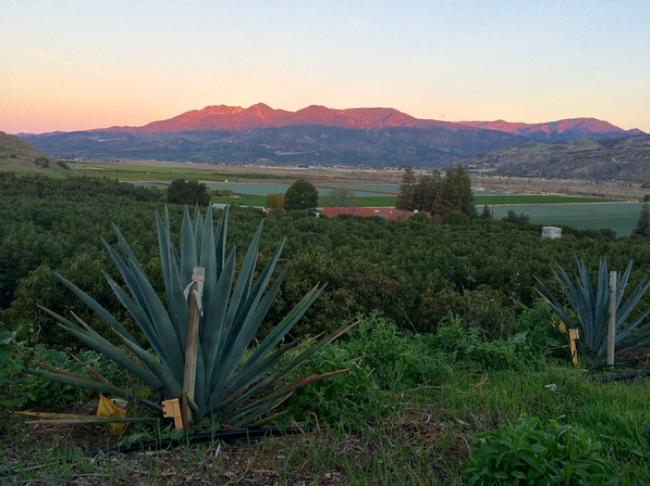
We will be highlighting more about agroforestry practices and the efforts of local producers in future blogposts, so stay tuned!
[1] USDA National Agroforestry Center. Agroforestry Practices. 2019. Available online: https://www.fs.usda.gov/nac/practices/index.shtml (accessed on 31 August 2018).
- Author: shulamit Shroder
When you think of armor, you might think of medieval knights protecting damsels in distress. For Frank Fernandes of Legacy Ranch, though, the damsel in distress is his soil. To protect his soil from compaction and weed pressure, he has experimented with strip tillage and cover crops in his forage crop fields. He calls these practices “soil armor.”
Reduced tillage
Soil armor means keeping the soil covered as much as possible. Instead of tilling the corn residues into the soil, Frank uses a no-till drill to seed the next crop. This leaves the previous crop's stubble on the field, protecting the soil from erosion. The corn residue acts like a mulch and keeps the soil surface cool, reducing evaporation even on hot days.
In the photo below, you can see the stalks of corn that remain, even after he planted a new crop in the field. This residue will slowly break down and feed the microbes in the soil. It will eventually provide nutrients to later crops. 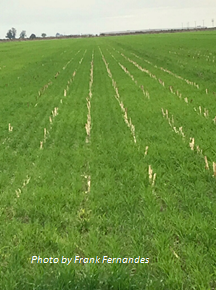
Cover crops
Frank also plants a diverse mix of cover crops between his corn and wheat rotation. This has reduced his weed pressure and enabled him to save money on herbicide applications and tractor passes.
One of the species he likes to plant is called a “tillage radish.” As you can see in the picture below, this plant develops a long, thick taproot that breaks up compaction. It decomposes quickly, leaving channels through which water can flow and roots can grow.
Benefits
Frank has experimented with these practices for a few years and has already noticed major improvements in these fields. His irrigation water percolates into the soil more quickly than it did in the past. He has increased the interval between irrigations, because the soil is able to hold onto more water. He has reduced the number of tractor passes. His fertilizer and herbicide needs have decreased. All these benefits have saved him tens of thousands of dollars.
What about yield? As might be expected for a new system, he has seen some drop in yields. However, this reduction has not been substantial and some fields have even reported increased yields. For Frank, the reduction in costs more than outweighs the slight reduction in yields. Yields should improve as the soil becomes healthier. 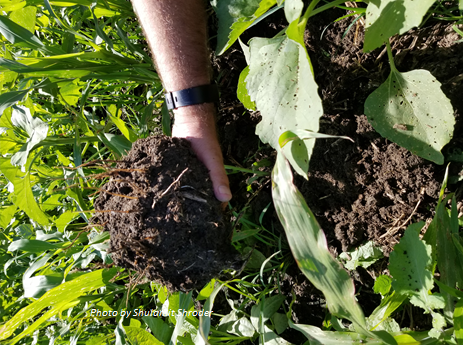
Climate smart agriculture encompasses management practices that increase soil carbon sequestration, reduce greenhouse gas emissions, improve yields and efficiencies, and promotes climate resilience. The California Department of Food and Agriculture (CDFA) supports three funding opportunities in climate smart agriculture: the Healthy Soils Program, the State Water Efficiency & Enhancement Program, and the Alternative Manure Management Program.
In a collaborative partnership, CDFA and UC Agriculture and Natural Resources have teamed up to support 9 community education specialists throughout the state to provide technical assistance and outreach for the climate smart agriculture programs. To learn more and locate a specialist near you, visit http://ciwr.ucanr.edu/Programs/ClimateSmartAg/.
- Author: Britta Leigh Baskerville

Just North of Fort Bragg, down a country road, sits a small community with a big mission. “We strive to ameliorate the suffering and other negative impacts of climate disasters” it's stated on their website. Applying for a California Department of Food and Agriculture (CDFA) Climate-Smart Healthy Soils Program grant was a part of that mission.
The Meadow Farm Community Land Trust (MFCLT) is a 501(c)3 with a conservation easement obtained by the late founder and property owner, Joanna Becker, in 2013. This easement protects the land from non-farming development, and the organization's board have continued with that legacy since Becker's death in 2016. The property is a total of 28 acres, though only 3 acres are currently devoted to fruit and vegetable production. So far.
Their website, https://www.meadowfarm.org/, details the remarkable journey the residents of this land have taken to get this far, as well as their vision, mission, and aims. Building affordable housing for their resident farmers is an important goal of theirs.
“Farming doesn't make much money, and some of us don't need a lot, but we still need a place to call home.”says resident, Sojourna Lee.
On my recent visit to the farm, Lee described the frequency of farming volunteers falling in love with the place and staying on to build small housing for themselves with the potential of obtaining a 99 year lease. They're permitted to build 4 more community houses on the land, something that will allow for greater expansion of the farming projects with enough hands to achieve this.
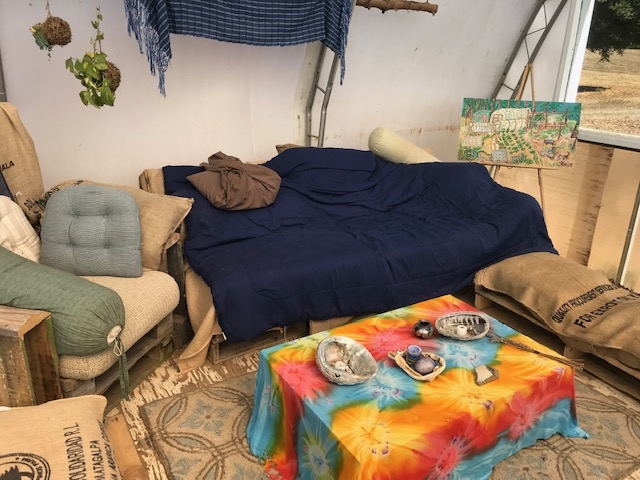
As a Community Education Specialist (CES) for the University of CA Cooperative Extension, I first reached out to MFCLT to congratulate them on being selected in the latest round of Healthy Soils Program awards. They were one of the 9 Mendocino County farmers selected, demonstrating a dedication to improving the soil quality on farms in the North Coast! Their award is for $17,765.11 going toward compost, mulch, and cover crop seed application and establishing a perennial hedgerow on a beautiful 6 acre meadow, which includes their 3 acre vegetable plot. In addition, MFCLT is contributing over $5500 in matching in-kind funds to complete this project.
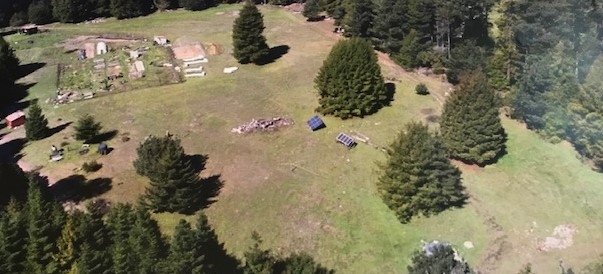
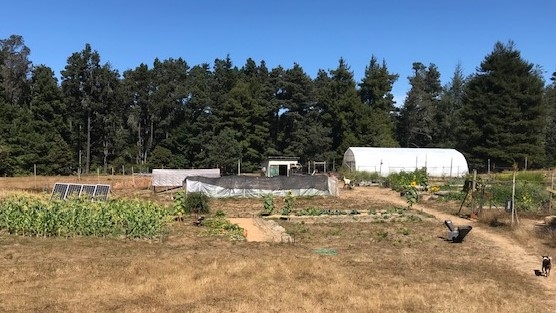
To apply, MFCLT's board member and resident, Ohi Vidaver, worked with conservation organization Fish Friendly Farming to complete the application process. This organization was a valuable Technical Assistance Provider (TAP) for many of the farmers in the area who were interested in applying. As our TAP contracts with the CDFA were not conflicting, I was able to supplement assistance once the applications were submitted and the award winners selected. This proved beneficial in the case of MFCLT, who had many questions and concerns around implementing their project now that they've been given the go-ahead to start.
Last week, I was invited to a delicious vegan curry lunch, prepared by members of their small crew, and was able to chat more with Lee and Vidaver about what was needed to get their project off the ground. As what is considered a Severely Disadvantaged Community, defined by the State Department of Parks and Recreation, they are eligible for up to 25% of the grant award to be paid in advance (as opposed to the standard invoice reimbursement). This is necessary, as the small non-profit is not able to pay the full cost of the project up front, but it is also a lengthy process to receive approval. Due to some delays with the CDFA's Office of Environmental Farming and Innovation, award winners were forced to wait over a month and a half from the advertised start date (July 1st) to receive their contracts that would allow them to start. On top of this, the deadline to implement year 1 of the project's practices is December 31st, 2019, giving them only 4.5 months, which will surely be hampered once the rains make it impossible to work the fields. This is an example of why some farmers hesitate to take advantage of government grants, as it will take a lot of time, feedback, and alterations before this program becomes practical to anyone except large-scale farmers with the resources available to work quickly. Still, Meadow Farm is determined to improve the soil quality of their land, and they are going to try their best with limited time, labor, and machinery. We discussed the local resources available for tool and labor sharing to make the daunting task of spreading compost, mulch, and seed over 6 acres less intimidating. This need, plus a mission to provide “an opportunity for enriching lives through affordable accommodations, permaculture, organic farming, education and other creative endeavors”makes it a great spot for workaways and volunteers to be a part of the magic of soil remediation and carbon sequestration. Touring the 6 acre meadow and seeing the potential of the land and of the community, I can see why some people choose to stay on as permanent residents.
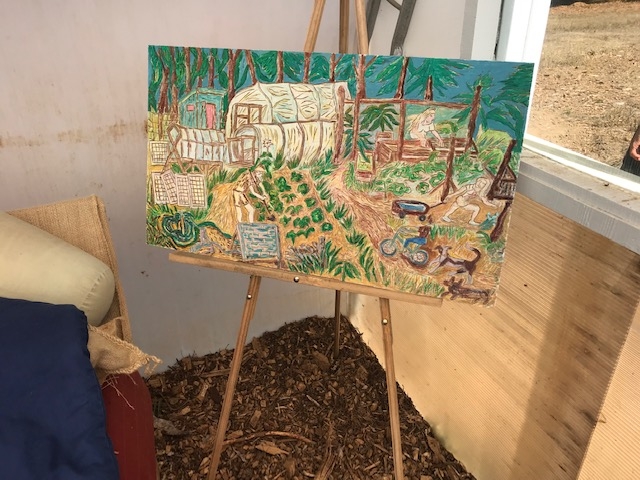
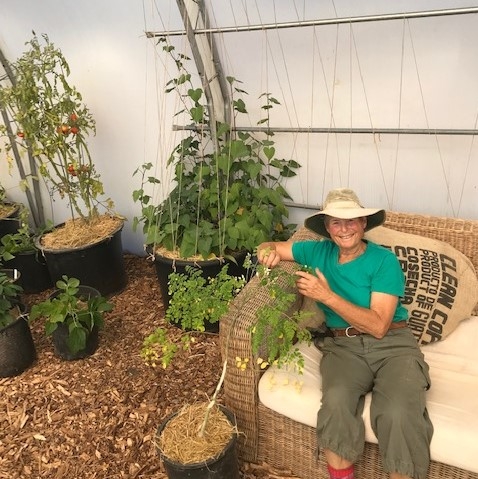
Stay tuned for more updates on the Healthy Soils projects as they unfold in the coming years! If you are near the Mendocino Coast, be sure to look up Meadow View Community Land Trust and take home some nutritious and diverse veggies exchanged on a donation-basis! There will likely be some organized volunteer work days in the coming months, which would be a great opportunity to get involved.
Climate smart agriculture encompasses management practices that increase soil carbon sequestration, reduce greenhouse gas emissions, improve yields and efficiencies, and promotes climate resilience. The California Department of Food and Agriculture (CDFA) supports three funding opportunities in climate smart agriculture: the Healthy Soils Program, the State Water Efficiency & Enhancement Program, and the Alternative Manure Management Program.
In a collaborative partnership, CDFA and UC Agriculture and Natural Resources have teamed up to support 9 community education specialists throughout the state to provide technical assistance and outreach for the climate smart agriculture programs. To learn more and locate a specialist near you, visit http://ciwr.ucanr.edu/Programs/ClimateSmartAg/.
- Author: Caddie Bergren
- Author: shulamit Shroder
Dairies produce lots of milk – and manure. The ingenious dairymen of the Central Valley often use one to produce the other. They grow forage crops like alfalfa and corn that they then feed to their cattle. To provide key nutrients to these crops and deal with the natural waste of a livestock operation, they can spread manure straight onto their fields or they can use effluent water to simultaneously irrigate and fertilize those fields.
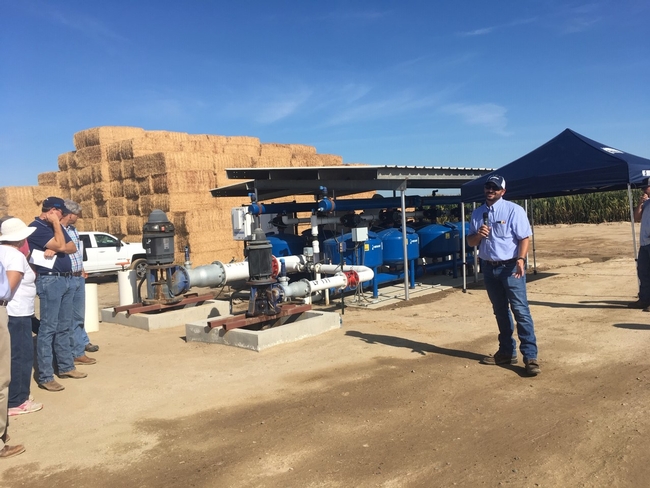
To apply that dairy effluent water, many farmers use flood irrigation systems. This is a cheaper, low-tech option, but it can require more ongoing labor and risks overwatering and nitrate leaching.
Subsurface drip irrigation is ideal for many forage crops and can significantly reduce water use, but dairy effluent water tends to clog up these systems.
A recent partnership between the USDA's Natural Resources Conservation Service, Netafim, Sustainable Conservation, and three dairy producers in the Central Valley teamed up to solve this problem. After three years of research and testing, they were able to share their success at two recent field days held on the dairies in Chowchilla and Buttonwillow.
To achieve success, the partners found they needed to customize the systems to each dairy's size and physical layout between lagoons and fields. To prevent clogging, they needed twice as many filters as they'd need for filtering canal or groundwater and they need to be flushed more frequently than other drip systems. But after three years of using and adjusting their system, the managers at DeJager Dairy in Chowchilla reported steady crop yields with significantly lower water use. The best part was the ability to monitor nutrient levels and schedule irrigation sets remotely from the comfort of their office.
At one pilot farm in the Buttonwillow area, the dairyman found that he reduced his water usage from 55 inches per corn crop under flood irrigation to 34 inches under subsurface drip. He also recorded a slight increase in yield. This enabled him to drastically increase the amount of crop he produced per drop of water he used. In addition to the increased water use efficiency, the farmer managed to save on labor costs by automating his irrigation system.
For an added bonus, UC Davis researchers measured a 90% decrease in the emission of nitrous oxide, a potent greenhouse gas.
With all the benefits of this new system comes one significant obstacle for dairymen: high upfront cost. But starting next year, NRCS will cost share up to 75% of the installation price for a limited number of years. Dairymen can also apply for the California Department of Food and Agriculture's Alternative Manure Management Program to help them better separate their solid and liquid wastes.
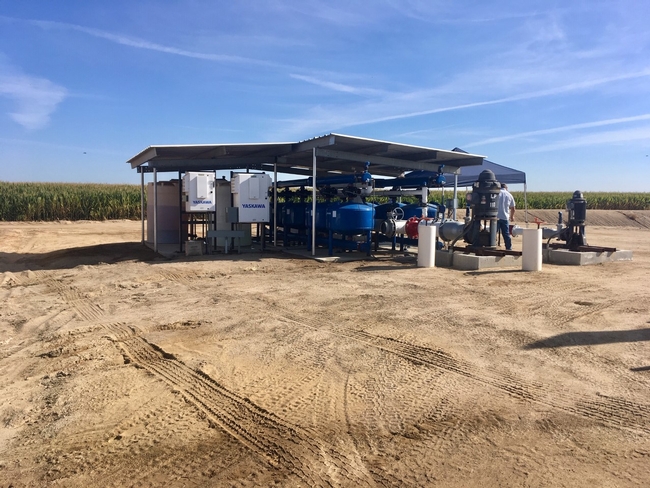
Climate smart agriculture encompasses management practices that increase soil carbon sequestration, reduce greenhouse gas emissions, improve yields and efficiencies, and promotes climate resilience. The California Department of Food and Agriculture (CDFA) supports three funding opportunities in climate smart agriculture: the Healthy Soils Program, the State Water Efficiency & Enhancement Program, and the Alternative Manure Management Program.
In a collaborative partnership, CDFA and UC Agriculture and Natural Resources have teamed up to support 10 community education specialists throughout the state to provide technical assistance and outreach for the climate smart agriculture programs.
- Author: Kristian M Salgado
You know you have reached the Imperial Valley, located on the southeastern bottom corner of California, when you begin to smell (not carne asada, but you're close) the distinct aroma of cow manure. This smell isn't manure coming from dairy cows as you might think though Imperial County does have two dairies. For the most part, the odor is coming from feedlots spread across Imperial County raising Holstein steers for beef.
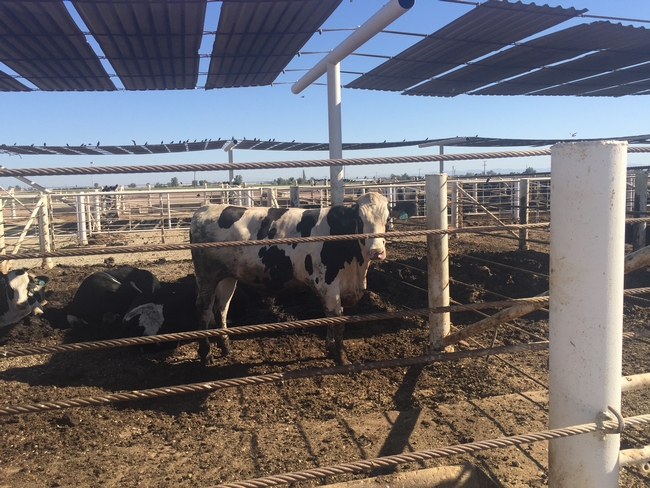
With an estimated total of 344,937 cattle[1],and the distinct smell as a reminder, you would imagine that Imperial County ranchers are managing a whole lot of cattle manure. “How are ranchers managing dairy and livestock manure?” has become a top concern for the California Department of Food and Agriculture (CDFA) over the past two decades. This is because 8% of California's Greenhouse Gas (GHG) emissions, mostly methane and nitrous oxide, comes from agriculture, and approximately two thirds of those emissions come from enteric fermentation and manure management of livestock[2].
On the manure management side of ranching, greenhouse gas emissions are largely due to the anaerobic (absent of oxygen) decomposition of volatile solids stored in a lagoon or other predominately liquid anaerobic environments that produce excess methane. In other words, methane is produced in greater quantities when exposed to these wet conditions of collection, treatment, and storage. California, especially in the Central Valley (where 91% of the state's dairy cows are located), utilize freestall barns with flush systems, settling basins, lagoons, and processing pits[3]. According to California Air Resource Board (CARB), by converting these systems to lower sources of manure methane, such as pasture-based management, compost-bedding pack barns, or solid separation, these dairies can reduce that amount of methane released into the atmosphere.
Manure management methods widely used by Imperial County ranchers are considered “alternative manure management methods” by CDFA and other government agencies. Due to the arid-low desert climate and low annual rainfall, Imperial County ranchers already manage dry manure systems that are considered low emissions by Methane Conversation Factors standards. For, instance a 30,000-cattle feedlot using (which is the average size for Imperial County feedlot) using a dry lot manure scraping system, with minimal tractor diesel fuel consumptions for scraping corrals produces about 2,509 Metric Tons of Carbon Dioxide (MTCO2e/yr). Which is equivalent to 6,134,474 miles driven by an average passenger car[4]. In addition to using a scraping manure system, it's also common practice for ranchers to haul their manure to a local compost facility or compost in-house using open solar windrows drying, depending on the feedlot. Composted manure is than often utilized locally or sold as a soil amendment for the farming of forage crops and other commodities.
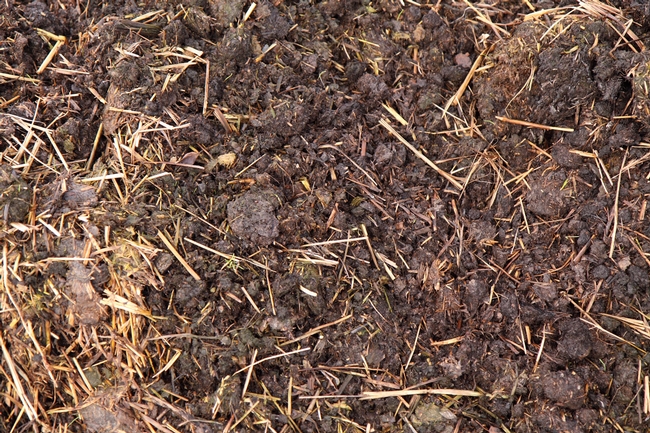
Cattle will always be a source of methane, however how rancher's management dairy and livestock operations could reduce the overall production of methane. On a regional scale, its fair to say that the Imperial County ranchers are implementing the best low methane manure management practices, while still producing a significant amount of cattle. Imperial County ranchers are always looking for better ways to improve their management, however many ranchers don't fall under the CDFA Alternative Manure Management Program guidelines (because they already use these practices) limiting their ability to access these funding opportunities.
Climate smart agriculture encompasses management practices that increase soil carbon sequestration, reduce greenhouse gas emissions, improve yields and efficiencies, and promotes climate resilience. The California Department of Food and Agriculture (CDFA) supports three funding opportunities in climate smart agriculture: the Healthy Soils Program, the State Water Efficiency & Enhancement Program, and the Alternative Manure Management Program.
In a collaborative partnership, CDFA and UC Agriculture and Natural Resources have teamed up to support 10 community education specialists throughout the state to provide technical assistance and outreach for the climate smart agriculture programs.
[1]https://www.co.imperial.ca.us/ag/docs/spc/crop_reports/2017_Imperial_County_Crop_and_Livestock_Report.pdf
[2]2018 Edition, California Greenhouse Gas Emission Inventory: 2000 – 2016
[3]https://ww3.arb.ca.gov/cc/dairy/documents/08-21-17/dsg1-dairy-101-presentation.pdf
[4]https://www.epa.gov/energy/greenhouse-gas-equivalencies-calculator

